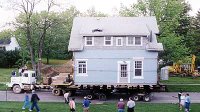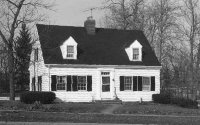 hilly location on the north end of the WRA campus. For many years this house, built in the early 1960s, stood at 301 Aurora Street with its back to our property. When the new owner proposed that the house be demolished in order to make way for a larger one, WRA was contacted about accepting the residence as a gift. The house has now been successfully moved to its new position on our campus, and by next summer, should be ready for a faculty family.
hilly location on the north end of the WRA campus. For many years this house, built in the early 1960s, stood at 301 Aurora Street with its back to our property. When the new owner proposed that the house be demolished in order to make way for a larger one, WRA was contacted about accepting the residence as a gift. The house has now been successfully moved to its new position on our campus, and by next summer, should be ready for a faculty family.It was not all that long ago that another house, the "Brick Academy," home to a girls' seminary in the mid-19th century, was moved from lower Aurora Street where it had stood next to the
 present Congregational Church since 1847. On Saturday, May 13, 2000, the structure began to make its way a quarter mile to a new location just behind the Knight Fine Arts Center on Oviatt Street. The move took all day. Once settled on a vacant Reserve lot, the structure underwent extensive restoration and received a kitchen and den addition to the rear of the house. It is now in use as a faculty residence.
present Congregational Church since 1847. On Saturday, May 13, 2000, the structure began to make its way a quarter mile to a new location just behind the Knight Fine Arts Center on Oviatt Street. The move took all day. Once settled on a vacant Reserve lot, the structure underwent extensive restoration and received a kitchen and den addition to the rear of the house. It is now in use as a faculty residence.In the past, other houses have been moved from our campus and at least two others were added. One house, known as the Kippen house (from the owner's family name) was purchased by WRA benefactor James W. Ellsworth in 1921 and moved from the corner of Chapel Street and College to its present location at 156 Aurora Street. Another home that stood near the corner of Prospect and College Street was either moved or demolished in the early 1930s in order to provide a place for the building of Hobart House.
Two faculty homes on Hudson Street were purchased as kits from the Sears catalog, were shipped to Hudson by rail, stored behind the old Bicknell Gym, then brought over to Hudson Street and assembled on site. These include the house sometimes called the Hickok house which was marketed by Sears as "The Milford" (catalog #3385) and listed for $1359 to $1671. WRA bought the Cape Cod-style house shown in the 1934 catalog and erected it during the summer of 1935.


The second Sears catalog house is right next door and was marketed as "The Newcastle" (catalog #3402) , a large two-story house whose design was based on that of the 1730 Richards House in Litchfield, Ct. This model sold for $1576 to $1813 and probably was assembled in 1936. Both houses are so substantial in their framework and detailing that few would guess they had arrived on campus in a box, or rather a boxcar. Most of these Sears houses had 30,000 or more pieces and came with 750 lbs. of nails. Sears suggested they could be assembled in 90 days. So in the middle of the Depression years, WRA was able to build two fine houses for faculty use in a very economical way.
